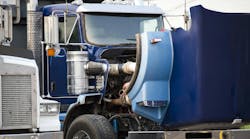When the American Jobs Creation Act went into effect on January 1, 2005, the calculation for the Federal Excise Tax (FET) on truck tires changed from a physical weight-based assessment to a flat rate based on the load carrying capacity of the tire.
Since then, standard radial truck tires have been taxed at a rate of 9.45¢ for every 10 lb. over 3500 lb. of carrying capacity. So a tire with a maximum single capacity of 6175 lb. will have an FET of $25.28. Bias tires and those classified as wide-base are taxed at a lower rate of 4.725¢ for every 10 lb. over 3500 lb. of carrying capacity.
The standard radial truck tire formula is quite clear: The more weight the tire carries, the higher the tax. However, on the bias/wide-base side, there are a couple of issues that have created confusion and potential problems for fleets that operate these tires.
For those who still use bias ply tires, particularly those in the intermodal market, the tax is based on the maximum single load carrying capacity for the tire. Some manufacturers have attempted to create a “discounted” FET by marking the tire for dual use only, thereby lowering the tax.
But every bias tire (except wide-base) must be labeled with both the single and dual load carrying capacities, and the values cannot be less than those published by various industry associations. So if a sales rep tells you he can save you money on FET with “specially labeled” tires, they're probably headed for an audit.
But the biggest FET landmine is waiting for fleets that operate wide-base tires. The definition for these tires is extremely vague and some tire companies determined that standard all-position wide-base tires qualified for the discounted rate. Of course, Congress and the IRS intended to give the break only to those using the new ultra-low-profile wide-base tires to exclusively replace dual tires. As a result, it's quite possible that there are thousands of dollars in back taxes that may be owed.
The good news for fleets is that the tire manufacturer is ultimately responsible for paying the FET. Even though the manufacturer passes it on to the dealer, who passes it on to the fleet, the IRS won't be knocking on any of your doors.
Manufacturers and dealers are working with Congress and the IRS to clarify the definition and resolve the issue of back taxes. In the meantime, some tire makers have already raised the FET on standard wide-base models and it's expected that everyone will soon be using the higher rate.
However, if by some remote chance the IRS determines all improperly calculated FET taxes must be collected — and the tire manufacturer decides to pass that on to the tire dealer — don't be surprised if the tire dealer sends you an invoice for FET on wide-base tires that you've purchased since January 1, 2005.
Let's hope it doesn't come to that. But it's better to start asking questions now to see if your tire supplier will pass those costs down the chain or just absorb them.
Ultimately, the change in FET calculation is a good thing for the industry. It standardizes the rate for most tire sizes and load ranges, which makes pricing much easier. And while I have no data or information to support the theory, it also eliminates the competitive edge for tires that may be manufactured in a way that makes them lighter, but less durable and reliable.


